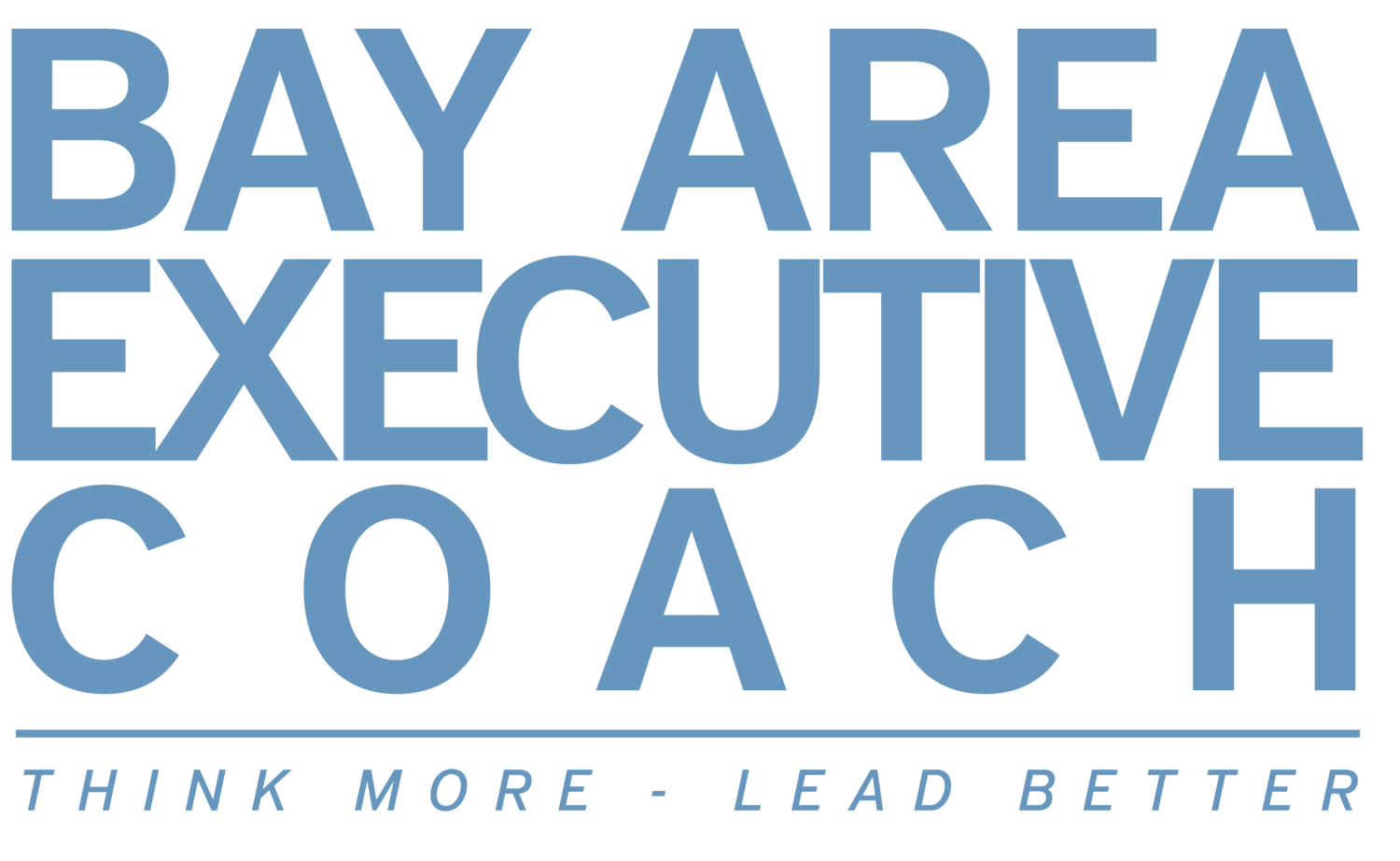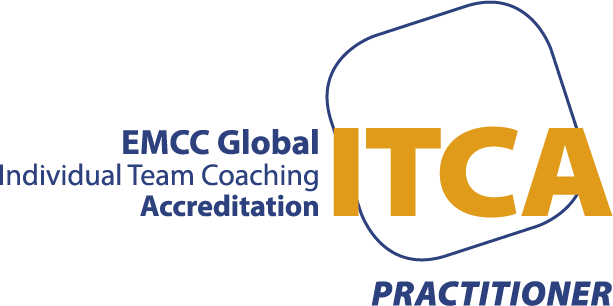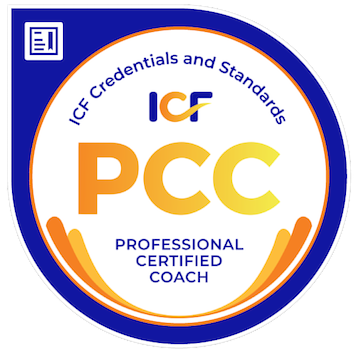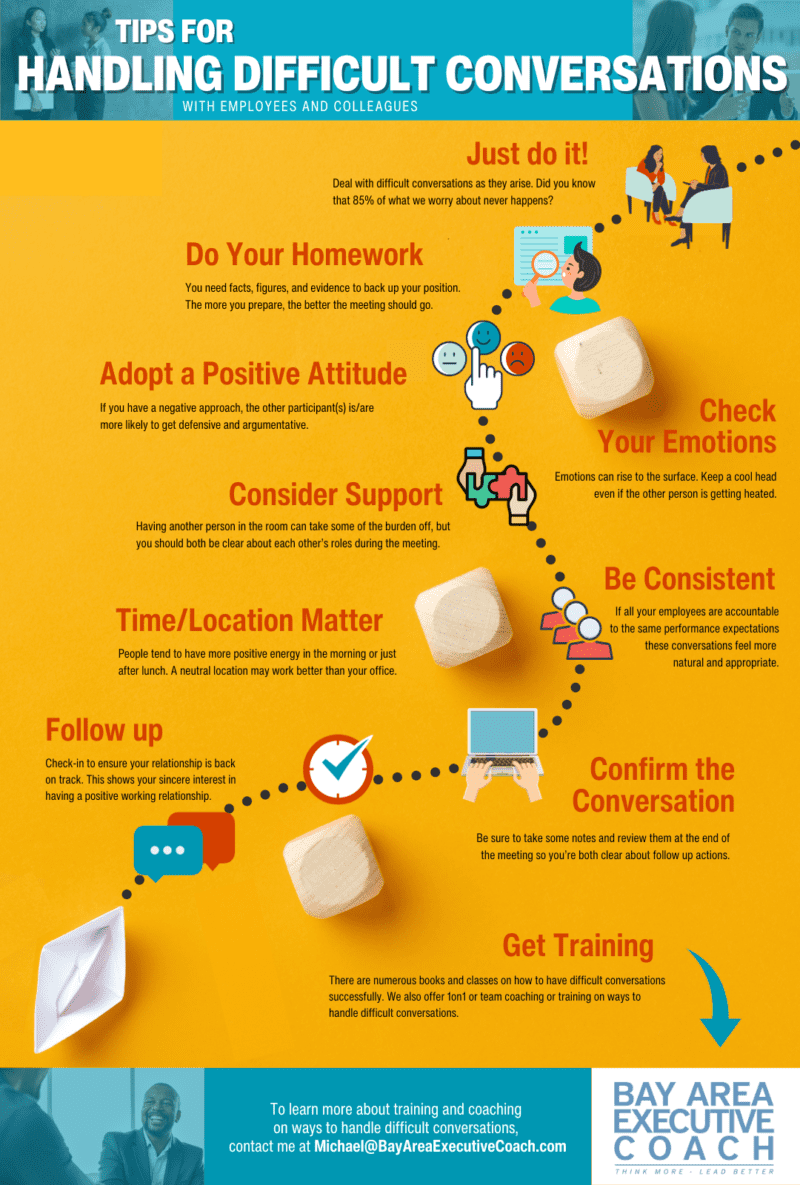
It’s safe to say that no-one, (well almost no-one) relishes contentious or difficult conversations with their employees or colleagues. And yet problems, and conflicts, seem endemic to human interaction within the workplace. Therefore, such conversations are a fairly common aspect of worklife.
As an executive or manager, you’ll undoubtedly be having these difficult conversations from time to time, and how you handle them can have a large bearing on their successful resolution.
Remember, your goal in these conflict conversations is to settle the matter at hand in a fair and equitable way that gets your relationship either back on track or stronger for it. While these conversations can be challenging, they can also provide opportunities for professional growth and development. So, here are some tips to deploy the next time you’re faced with convening a “difficult” conversation with an employee or even a colleague.
- Don’t put it off, just do it.
Avoiding these kinds of conversations rarely makes anything better. The longer you wait, the more it can affect the workplace environment, morale and productivity. So, reach out to the person you need to have a crucial conversation with, schedule a mutually convenient time and place, and get on with the meeting. The best leaders know that difficult conversations are part of the game and they deal with them as they arise. 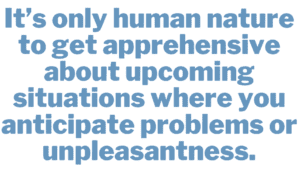
- Realize that what you are fearing is unlikely to happen
The prospect of having a difficult conversation can rattle even the coolest and calmest manager. It’s only human nature to get apprehensive about upcoming situations where you anticipate problems or unpleasantness. Moreover, it’s natural to imagine how the situation could get worse by having the conversation in the first place. However, many years ago, Dale Carnegie said that much of what we worry about never happens.
Indeed, researchers at Cornell put a number on it. Their research determined that 85% of what we worry about never happens. This should give you a bit more confidence to follow tip number one up there.
- Do your homework before the meeting.
The more you prepare, the better the meeting should go. You don’t want to pull employees in and address them based solely on your own personal observations or opinions. You need facts, figures, and evidence, and other forms of verifiable information to back up your position. If an employee is consistently violating a particular company policy, then you need to have that policy in the meeting as a printed document or on screen to back up your position. If they are not behaving in alignment with one of the company’s stated values, then have that list ready to share. Make sure you understand and are knowledgeable about the situation as much as possible before the meeting starts.
- Adopt a positive attitude.
It’s important to set a positive tone going into your meeting. If you have a negative approach, the other participant(s) is/are more likely to get defensive and argumentative. Don’t criticize or berate out of spitefulness. Instead, identify the problem and cite examples of positive things the other person can do to improve the situation. Don’t tell people only what they’re doing wrong, find positive things to talk about too that are relevant to the conversation.
Go further and provide the tools and resources that may support the change you are seeking in the other person. Every situation is different, but always try to put yourself in their shoes. Would you rather be dressed-down or treated as a reasonable, responsible person who simply needs information and guidance?
- Check your emotions at the door.
Difficult meetings can get tense, and emotions can rise to the surface. Seek to be the role model and keep a cool head even if the other person is getting heated. This is certainly easier said than done, but you will get better with practice. Keep the meeting focused on the topic and the facts. If you can anticipate what might trigger the other person and avoid certain phrases, that may help. And know what words and phrases trigger you so you can let them come and go if they are uttered by the other person. This is part of your preparation for a difficult meeting.

- If necessary, have a support person attend.
You never want to give the impression you’re ganging up on someone, but having another person in the room can take some of the burden off of your shoulders in difficult meetings. For example, if the meeting is about a personnel related problem, it might be advised to have someone from HR in the meeting. If it’s about a legal issue, then having a person from your in-house legal team can be helpful. Your third party should be briefed on the situation to ensure that you’re both clear about each other’s roles and responsibilities during the meeting.
If you are really angry at the other person, then you may find it easier to control your emotions by letting the support person facilitate the meeting and keep it focused on the present and future. Don’t go back to the past any more than is absolutely necessary.
- Be consistent.
Hold all your employees accountable to the same performance expectations.
Have the same style of dialogue with everyone. Don’t imply favoritism or appear that you’re picking on or alienating someone. When you’re even handed in holding everyone to the same standards, these conversations feel more natural and appropriate.
- Document the conversation if necessary
If the conversation is generating follow-up actions, be sure to take some notes and review them with the other person so you’re both clear as you end the meeting. This will ensure that you don’t have to have another difficult conversation about why one of you didn’t follow through on your commitments.
- Choose the appropriate location, and time.
Be strategic about when to have the meeting. Most people are tired in the mid to late afternoon. That’s probably not the best time to have a difficult conversation. You may want to choose a morning time or just after lunch when people tend to have a renewed sense of energy. As for location, consider whether a neutral location rather than your office may work best. If you need to have it as a remote meeting, then have a pleasant background, have a neutral or positive expression and make eye contact with the other person to show you’re engaged in the conversation.
- Follow up with the other person if appropriate
Some conversations bear a check-in to ensure your relationship is back on track. This check-in is also an opportunity to show your sincere interest in having a positive working relationship with the other person. It shows you care. And you know what Maya Angelou said. ‘I’ve learned that people will forget what you said, people will forget what you did, but people will never forget how you made them feel.”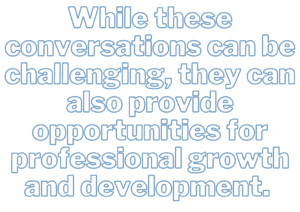
- Get some training
There are numerous books and classes on how to have difficult conversations successfully. It can really help you to get educated beyond what we’ve shared here and learn a process. You may also get opportunities in a class to practice certain phrases with others that support effectively having difficult conversations. We do offer such classes if you would like to consider us a resource.
If you follow these ideas, you’ll find that “difficult conversations” needn’t be as difficult as you previously imagined. You may not end up relishing them, but you’ll move past dreading them and having them with confidence that shows yet another great side of your leadership presence.
If you would like 1on1 or team coaching or training on ways to handle difficult conversations, please contact us to learn more. You might also find our case study, “How Conversational Intelligence Helped resolve Friction”.
To learn more about leadership, watch our video:
Featured photo is from ©SHIVETS Production via Pexels. Secondary photo is from ©Tina Miroshnihenko via Pexels.
